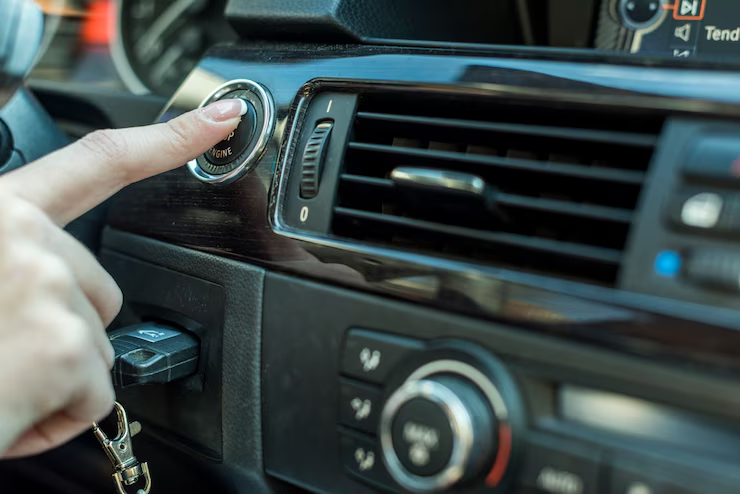
How to Get Weed Smell Out of a Car:
Getting rid of weed smell in a car can feel like a daunting task, but it is entirely manageable with the right approach. To effectively eliminate the odor, deep clean the interior, focusing on upholstery, carpets, and any surfaces where smoke may have settled. This method not only helps remove the smell but also refreshes the vehicle’s overall environment.
Air fresheners and odor-eliminating products can mask the scent temporarily, but they won’t solve the problem at its source. Techniques such as using vinegar, baking soda, or activated charcoal are proven to neutralize odors. It’s important to ensure proper ventilation and utilize a thorough cleaning regimen to achieve the best results.
Many people overlook the significance of the cabin air filter, which can trap unpleasant scents. Replacing or cleaning this filter can significantly improve the air quality inside the vehicle. Knowing these steps will help maintain a fresh-smelling car, making it more enjoyable for both the driver and passengers.
Understanding Car Odors

Cars can absorb a variety of odors from different sources. Identifying these sources and understanding how they impact the interior environment is crucial for effective odor removal.
Differentiating Odor Sources
Cars can develop distinct smells that originate from various sources. For instance, a burnt or fuel-like odor may indicate a gas leak, which requires immediate attention. Conversely, cigarette smell often lingers from smoke residues that cling to upholstery and hard surfaces.
Food remnants or spills can create unpleasant scents, which can be exacerbated by heat or humidity. Environmental factors, such as dampness, can lead to mold or mildew smells. Recognizing the specific odor helps in determining the appropriate removal method.
Why Cars Absorb Smells
Cars absorb odors due to their materials and enclosed spaces. Upholstery, carpets, and plastics are porous, allowing them to trap smells. Additionally, air conditioning systems can circulate stale air or odors throughout the vehicle.
Factors like humidity and temperature can intensify these smells. For example, a car leaking water may lead to mildew odors if left unchecked. The heat blowing cold air can indicate a coolant leak or malfunction, further complicating odor issues.
Understanding these aspects can aid in restoring a more pleasant environment.
Immediate Steps to Mitigate Weed Smell
To effectively reduce the smell of weed in a car, it’s essential to use efficient ventilation techniques and apply odor neutralizers. Taking immediate action can significantly improve the situation.
Ventilation Techniques

Proper ventilation is crucial when addressing weed smell. Start by rolling down windows to allow fresh air to circulate inside the vehicle. This simple step can help dilute the odor quickly.
Open all doors for a more thorough air exchange. This method allows stale air to escape while fresh air enters, removing lingering smells.
If available, use a fan or portable air purifier. A fan can help push odors out through open windows, while an air purifier will enhance air quality inside the car.
Consider parking in shaded areas when airing out the vehicle. Sunlight can intensify odors and heat up the interior, making it harder to eliminate smells.
Using Odor Neutralizers
Odor neutralizers can effectively tackle persistent smells. Look for products specifically designed to eliminate smoke and cannabis odors.
Activated charcoal pouches are excellent for absorbing odors without leaving behind chemicals. Place these pouches in various spots, such as under seats or in cup holders.
Another option is an enzyme-based spray. These sprays break down odor-causing compounds. Spray lightly in affected areas and allow it to dry.
Baking soda is a simple yet effective solution. Sprinkle it on upholstery and carpets, leave it for a few hours, then vacuum it up. This method absorbs unwanted smells.
Using these techniques will significantly aid in mitigating weed odor in the car.
Deep Cleaning Solutions
Removing weed smell from a car involves thorough cleaning of upholstery and carpets, treating the air conditioning system, and ensuring window and windshield cleanliness. Each of these methods contributes to a fresher interior.
Cleaning Car Upholstery and Carpets
To clean upholstery and carpets, a vacuum is essential to remove loose particles. After vacuuming, use an enzyme-based cleaner designed for automotive fabrics. This type of cleaner breaks down odor-causing substances.
- Apply the cleaner to the affected areas.
- Allow it to sit for 10-15 minutes.
- Blot with a clean cloth to absorb moisture.
For stubborn odors, a steam cleaner can be effective.
Always test any product on an inconspicuous area first to check for colorfastness. Regular cleaning helps maintain freshness over time.
Treating the Air Conditioning System
The air conditioning system can harbor odors. To address this, replace the cabin air filter. A clogged filter can circulate smells throughout the vehicle.
Next, spray an A/C cleaner or deodorizer into the intake vents while running the A/C on recirculate mode. This process allows the cleaner to circulate through the system, neutralizing lingering odors.
Additionally, running the A/C with the windows open for about 10 minutes helps to expel any trapped scents. Regular maintenance of the A/C system ensures continued performance and odor control.
Maintaining Window and Windshield Cleanliness
Cleanliness of windows and windshields contributes to an overall fresher environment. For the inside of car windows, a cleaner like Windex can be used.
- Apply the cleaner to a microfiber cloth, not directly on the glass.
- Wipe in a circular motion to remove film and odors.
For windshield maintenance, ensure that both inside and outside surfaces are clean, as residue can contribute to bad smells.
Using a dedicated automotive glass cleaner is advisable for best results. Regular cleaning of glass surfaces will help maintain visibility and freshness.
Preventive Measures and Best Practices

Maintaining a vehicle’s interior to prevent lingering odors is essential. Implementing a no-smoking policy and ensuring regular vehicle maintenance can significantly reduce the risk of retaining unpleasant smells, including weed.
Implementing a No-Smoking Policy
Establishing a strict no-smoking policy within the vehicle is crucial. This measure not only deters the introduction of cannabis odor but also keeps the interior cleaner.
Consider placing clear signage in the car, reminding passengers of the no-smoking rule. If smoking has occurred, it’s vital to air out the vehicle immediately.
Encourage the use of personal air purifiers or odor-neutralizing sprays specifically designed for vehicles. These products can help neutralize any traces of smell that may occur from previous use.
Regular Vehicle Maintenance
Regular maintenance of the vehicle goes a long way in preventing odors. Cleaning the upholstery and carpets every few months helps eliminate stubborn smells.
How often to wash your car? Aim for a wash every 2-4 weeks, depending on usage. Utilize specialized cleaning products that target odors effectively.
For additional protection, consider using a cargo liner. What to use for a cargo liner in a car? Heavy-duty, waterproof materials like rubber or plastic liners can trap contaminants, making them easier to clean while safeguarding the car’s interior.
Implementing these practices will ensure a fresher atmosphere in the vehicle.
Specialized Cleaning Techniques
Effectively removing weed smell from a car involves specialized techniques tailored to various substances and persistent odors. Dealing with residual effects from smoke and other contaminants is essential for achieving a fresh environment.
Removing Residue from Various Substances
Different substances can contribute to unwanted odors and stains. For sticky residues, such as resin or tar from cannabis, use a solvent-based cleaner. Apply it on a cloth and gently rub the affected area. For sap, mix equal parts of isopropyl alcohol and water, applying it to the sap with a soft cloth until it lifts.
Water spots can be tackled using a mixture of vinegar and water. Spray the solution, let it sit for a few minutes, and wipe with a microfiber cloth to avoid scratches. If dealing with stubborn bugs or paint, a dedicated bug and tar remover or a clay bar can effectively lift these residues without harming the vehicle’s finish.
Dealing with Persistent Smells
Persistent odors often require a thorough approach. Start by using an ozone generator, which can neutralize odors at the molecular level. When using this device, ensure the vehicle is well-ventilated after treatment.
For lingering smoke smell, consider an enzymatic cleaner. These products break down odor-causing compounds and can be sprayed on upholstery. Vacuuming the carpets and seats is also crucial, as debris may trap odors. Lastly, replacing cabin air filters improves air quality and eliminates trapped smells from the ventilation system.
Professional Assistance and Services
Seeking help from professionals can be an effective way to eliminate lingering weed odors from a car. Various services specialize in cleaning and deodorizing vehicles, providing more thorough solutions than at-home methods.
When to Seek Professional Cleaning
Professional cleaning becomes necessary when DIY methods fail to produce satisfactory results. If the smell persists after multiple attempts to clean the vehicle, it might indicate that the odor has penetrated deep into the upholstery or carpets.
Additionally, if the vehicle has visible residues or stains from spilled substances, professionals have the expertise to address these issues more effectively. Factors such as time constraints or a lack of appropriate cleaning supplies might also lead someone to consider hiring a professional service.
Options for Professional Deodorizing
Several options exist for professional deodorizing. Many automotive detailers provide specialized services that include deep cleaning, steam cleaning, and ozone treatments.
- Deep Cleaning: This involves thoroughly shampooing the carpets and upholstery to remove hidden residues.
- Ozone Treatments: This method uses ozone gas to neutralize odors at a molecular level, reaching areas that traditional cleaning cannot.
Some companies offer full detailing services that cover both interior and exterior cleaning. It’s advisable to check for customer reviews and credentials before choosing a service. The cost may vary significantly based on the service provided, typically ranging from $50 to several hundred dollars depending on vehicle size and condition.
Legal and Safety Considerations

Navigating the complexities of cannabis odor removal involves understanding legal rights and prioritizing safety during the cleaning process. It is crucial to be aware of search and seizure laws and the necessary precautions while addressing odors in the vehicle.
Understanding Search and Seizure Laws
In many jurisdictions, law enforcement must have probable cause or a warrant to search a vehicle. This means that a cop cannot search a car solely based on the presence of a cannabis smell without additional evidence. If an officer suspects illegal activity, they may request to search, but individuals have the right to refuse.
If they do search without proper cause, any evidence collected could be deemed inadmissible in court. It’s important to know local laws, as regulations regarding cannabis vary significantly. Keeping the car free from evidence of illegal substances can help mitigate legal risks.
Safety Measures during Cleaning
Cleaning a car to remove the smell of weed requires adopting certain safety measures. Using ventilation is critical; open windows or doors while cleaning. This helps disperse potent odors and prevents inhaling strong fumes from cleaning products.
Utilizing gloves and masks can protect against any irritants in cleaning solutions. Opting for natural cleaners, such as vinegar or baking soda, can reduce chemical exposure. If using commercial products, ensure the area is well-ventilated.
Consider using odor neutralizers designed specifically for vehicles. These can be effective in eliminating persistent smells without introducing harmful chemicals.
Car Odor and Selling Your Vehicle
The presence of unpleasant smells in a vehicle can significantly impact its sale potential and market value. Understanding how odors affect buyer perceptions and the importance of disclosure can guide sellers in making informed decisions.
Impact of Odors on Car Value
Odors like cannabis can deter potential buyers and reduce the vehicle’s perceived value. A buyer may question the cleanliness and maintenance of a car that smells bad. This can lead to lower offers or even a total lack of interest.
To mitigate this, sellers should:
- Deep Clean the Interior: Remove any lingering smells with thorough cleaning.
- Use Odor Eliminators: Products like ozone generators or activated charcoal can help eliminate persistent odors.
- Consider Professional Detailing: Hiring experts can ensure a comprehensive clean.
Addressing odors prior to listing may lead to a more favorable sale price.
Disclosure Requirements
When selling a vehicle, honesty about its condition is crucial. Sellers must disclose any known issues, including odors that may affect the vehicle’s appeal. Failing to disclose can result in legal issues or buyer dissatisfaction.
In certain jurisdictions, sellers are required to provide a disclosure form that includes all known problems. This may include details about past repairs or any significant odor problems:
- State Regulations: Sellers should familiarize themselves with specific laws in their area.
- Buyer’s Rights: Buyers have the right to know the vehicle’s history, including any odors that could indicate deeper issues.
Transparency helps build trust and can lead to smoother transactions, minimizing the risk of disputes or returns.
Additional FAQs and Troubleshooting
Addressing lingering odors in a vehicle can be challenging. Understanding common questions and troubleshooting persistent odor issues can help maintain a fresh environment in the car.
Common Questions about Vehicle Odors
Many car owners frequently ask how to remove specific odors, such as weed smell. Effective methods include using activated charcoal, which absorbs odors, or placing baking soda on surfaces for a few hours before vacuuming.
Another common concern involves pets or food spills, where odors can become stubborn. Spot cleaning with a mixture of vinegar and water can neutralize odors.
In cases of insect infestations like ants, regular cleaning can deter them. If ants have made a home in the car, using a mixture of water and dish soap can kill them while cleaning the area.
Troubleshooting Persistent Odor Issues
For persistent odors, thorough cleaning is essential. Vacuuming the upholstery and carpets can eliminate hidden particles causing the smell.
Using an ozone generator can also be effective. It purifies the air and eradicates odors; however, caution is necessary as it can damage some materials.
If odors still linger, replacing cabin air filters may help. Filters can trap particles that contribute to unwanted smells.
It’s crucial to identify the source of the odor. For example, in a luxury car like an Acura, high-quality materials might affect how odors are absorbed. Checking areas under the mats and between seats can provide insight into hidden smells.



